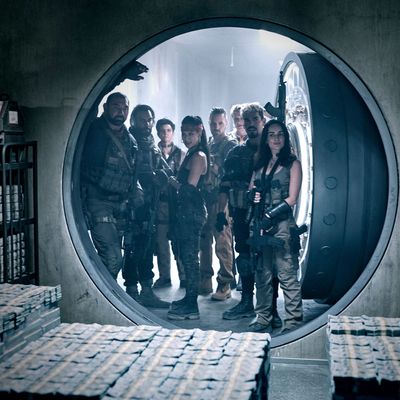
Zack Snyder’s Army of the Dead begins exactly how a Vegas heist movie set during a zombie apocalypse should: with a guy getting a blow job while driving his car in the Nevada desert, accidentally ramming into a top-secret military convoy, and unleashing the sinister results of a clandestine government project. Then comes exactly the right opening-credits sequence: Over a Richard Cheese and Alison Crowe cover of “Viva Las Vegas,” swarms of zombie showgirls, pageant queens, Elvis impersonators, and hotel maids feast on the people of Sin City. As the music continues, the mayhem accelerates and expands (in slow motion, of course, because Zack Snyder) as we are introduced to our main characters escaping the undead, blowing away zombies, and sacrificing loved ones. The military tries to take control and fails. (My favorite image: a paratrooper desperately firing away at the slavering throng of monsters below as his parachute lands him ever so gently in their midst, whereupon he is consumed.) Then, Vegas is bombed, an improvised cordon of giant shipping containers is stacked around it, and the city is ceded to the undead.
End opening credits. This is the first 15 or so minutes of Army of the Dead, and it is basically perfect.
The next hour or so is quite engaging, too. Scott Ward (Dave Bautista), a mercenary behemoth now working a grill in a dead-end diner, is enlisted by a mysterious billionaire (Hiroyuki Sanada) to go back into Zombie Vegas, break into a vault under a casino, and retrieve the fortune stashed there. One added complication: The U.S. military has decided to nuke the city on the upcoming Fourth of July holiday, so Scott and whomever he brings along basically have one day to accomplish all this. So, Scott and his old pal Cruz (Ana de la Reguera) start assembling a team, Dirty Dozen/Seven Samurai–style. The group includes, among others, a traumatized, buzzsaw-toting badass (Omari Hardwick); a brilliant but inexperienced German safecracker (Matthias Schweighöfer); a wisecracking helicopter pilot (Tig Notaro); a YouTube star (Raúl Castillo) famous for his zombie-killing videos; and a stoic French “coyote” (Nora Arnezeder) who has experience leading groups of renegades back into and out of the undead city. Joining in at the last minute are a corporate overseer (Garret Dillahunt) and Kate (Ella Purnell), Scott’s semi-estranged daughter, with whom he still has unresolved issues over that time he stabbed her zombie mother in the brain.
The initial scenes of the gang’s entry into Las Vegas offer promise as well, with Snyder concocting interesting spins on familiar zombie tropes. Surrounding Vegas is a quarantine area, filled with refugees living in tents who seem to be stuck in a bureaucratic no-man’s-land, preyed upon by craven guards. Once we’re inside Vegas proper, we see an undead version of one of Siegfried and Roy’s tigers roaming the devastated streets. Giant piles of desiccated zombies clutter the place. They got left in the sun too long, but we’re told they’ll come back to “life” if it rains.
Vegas, it seems, is controlled by a hierarchy of the undead: The shamblers who make up the mindless cannon-fodder swarms are ruled by a group of alphas who are smarter, faster, and (I can’t believe I am writing this word) hotter than your average brain-eating animated corpse. The alphas can be kept at a distance, somewhat, by making them a human offering. An early scene of the characters gingerly navigating a building filled with hibernating zombies (who sleep standing up) is wonderfully tense. The two towers of the casino they have to rob are called “Sodom” and “Gomorrah.” The impenetrable safe they must crack is called “Götterdämmerung” and was built by a guy named Wagner. Never have the Snyderisms come so relentlessly, and never have they felt more welcome.
And then, it all somehow goes south. Once the zombie killing starts in earnest, Army of the Dead becomes profoundly less interesting and more predictable. It’s a tale of two Zack Snyders: Gone is his flair for the mythic and the perverse, replaced by his baffling fondness for generic action spectacle. It doesn’t help that the script (credited to Snyder, Joby Harold, and Shay Hatten) appears to have borrowed most of its story beats from James Cameron’s Aliens — from the inevitable double cross, to the lost civilian who must be saved, to several other late-movie plot twists that I won’t reveal here. As a result, many of the story developments that should ideally keep us watching instead feel played out before they even occur: We’re constantly one step ahead, easily anticipating each big moment because, frankly, we’ve seen it before, in a better film.
Snyder is the kind of action auteur whose sensibilities can start wars among viewers. And maybe even among studio execs: Is there any other filmmaker out there who is repeatedly given so much power, only to have it pulled back at the last minute? With the March release of the so-called “Snyder Cut” of his Justice League, the director managed to make many of his critics (including yours truly) think twice: His four-hour version of that superhero epic, while certainly overstuffed and indulgent, was far more rewarding and moving than the compromised theatrical version. You took the good with the bad, because the good far outweighed the bad.
While the suits who cut up Justice League have now been semi-canceled and proven wrong, the idea that Zack Snyder movies are sometimes maybe — just maybe — too long and a little too self-important remains a notion worth exploring. Netflix, notorious (and beloved) for giving its A-list auteurs all the freedom in the world, seems in some ways an ideal place for the director to land, far from corporate bean counters and cutting-room busybodies. And at first, the match seems made in heaven: There’s a great movie in here somewhere, and for a while, we’re watching it.
But those opening credits, mixing Vegas kitsch and color with gritty zombie-picture shlock, and those opening scenes, mixing action-movie character development with welcome bits of deadpan humor delivered by a game cast, set up an experience Snyder seems increasingly less interested in delivering over the course of this film. Army of the Dead — which, let me reiterate, is a Vegas heist flick set during a zombie apocalypse — should be a lot more fun than it is. Or maybe more accurately, it should be as fun in the middle and toward the end as it is at the beginning. It starts off great. But then it goes on. And on. And on. And takes itself ever more seriously at each turn. By the end, any buoyancy has disappeared into a familiar wasteland piled high with corpses and exploding heads.





